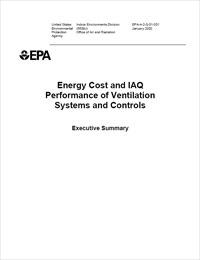Ventilation Systems and Controls Study
Indoor Air Quality (IAQ) in Large and Commercial Buildings
Energy Cost and IAQ Performance of Ventilation Systems and Controls Study
In 1999, EPA completed an extensive modeling study to assess the compatibilities and trade-offs between energy, indoor air quality and thermal comfort objectives for HVAC systems, and to help formulate strategies to simultaneously achieve superior performance on each objective.
Variations of Constant Volume (CV) and Variable Air Volume (VAV) HVAC systems were modeled in three different climates:
- hot and humid (Miami)
- temperate (Washington D.C.)
- cold (Minneapolis)
Buildings included several variations of an office building, plus a school and an auditorium.
This study addressed three major issues:
- How well can commonly used HVAC systems and controls be relied upon to satisfy generally accepted indoor air quality standards for HVAC systems when they are operated according to design specifications?
- What is the energy cost associated with meeting ASHRAE indoor air quality performance standards for HVAC systems?
- How much energy reduction would have to be sacrificed in order to maintain minimum acceptable indoor air quality performance of HVAC systems in the course of energy efficiency projects?
Documentation of the study is contained in the Executive Summary along with 7 individual detailed reports.
Project Reports
- Project Objectives and Methodology - Project Report 1
- Assessment of CV and VAV Ventilation Systems and Outdoor Air Control Strategies for Large Office Buildings: Outdoor Air Flow Rates and Energy Uses - Project Report 2
- Assessment of CV and VAV Ventilation Systems and Outdoor Air Control Strategies for Large Office Buildings: Zonal Distribution of Outdoor Air and Thermal Comfort Control - Project Report 3
- Energy Impacts of Increasing Outdoor Air Flow Rates from 5 to 20 cfm per Occupant in Large Office Buildings - Project Report 4
- Peak Load Impacts of Increasing Outdoor Air Flow Rates from 5 to 20 cfm per Occupant in Large Office Buildings - Project Report 5
- Potential Problems in IAQ and Energy Performance of HVAC Systems When Outdoor Air Flow Rates Are Increased from 5 to 15 cfm per Occupant in Education Buildings, Auditoriums and Other Very High Occupant Density Buildings - Project Report 6
- The Impact of Energy Efficiency Strategies on Energy Use, Thermal Comfort and Outdoor Air Flow Rates in Commercial Buildings - Project Report 7

